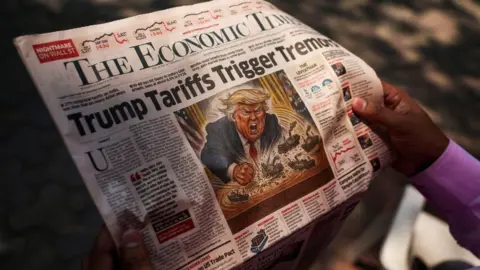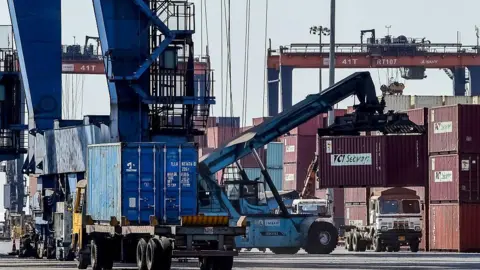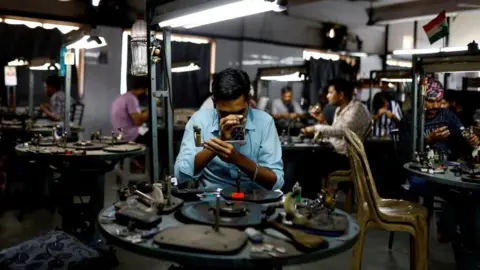Will trade-shy India gain edge in tariff-driven slowdown?
 Reuters
ReutersIndia is the world's fifth-largest and fastest-growing major economy.
Yet, a recent legacy of protectionism and inward-focused trade policies have held back its global competitiveness.
Its tariffs are high and the share of global exports remains under 2%. India's vast domestic market has fuelled its growth - outpacing many others, economists argue, largely because the rest of the world is slowing. But in a turbulent, increasingly protectionist era, India's instinct for self-reliance may oddly serve as a short-term shield.
As countries scramble to recalibrate in response to shifting US trade policies - like Donald Trump's latest 90-day tariff pause after weeks of sabre-rattling - India's relative detachment may have helped it weather shocks that have jolted more trade-dependent economies.
"India's lower exposure to global goods trade could work in our favour. If export-driven economies slow down under tariff pressure, and we continue growing at 6%, we'll start looking stronger by comparison - especially with our large domestic market to fall back on," says Rajeswari Sengupta, an associate professor of economics at Mumbai-based Indira Gandhi Institute of Development Research.
"Being trade-shy has turned into an advantage - but we can't afford complacency. To seize new opportunities, India must stay nimble and open up more to trade gradually and strategically," she adds.
It may not be easy, given India's long and complicated relationship with trade barriers and tariffs.
 AFP
AFPIn his book India's Trade Policy: The 1990s and Beyond, Columbia University economist and noted trade expert Arvind Panagariya traces the complex and often inconsistent evolution of India's approach to trade.
During the inter-war years, industries like textiles and iron and steel lobbied for - and received - high levels of protection. The chronic shortages of World War Two led to even stricter import controls, enforced through an elaborate licensing system.
While Asian peers such as Taiwan, South Korea and Singapore shifted to export-led strategies in the 1960s - and began posting impressive growth rates of 8–10% annually - India chose to double down on import substitution. As a result, imports as a share of GDP shrank from 10% in 1957–58 to just 4% by 1969–70.
By the mid-1960s, India had banned imports of consumer goods altogether. This not only removed the pressure on domestic producers to improve quality but also denied them access to world-class inputs and technology.
As a result, Indian products lost their competitiveness in global markets and exports stagnated. The resulting foreign exchange shortages led to even tighter import controls, creating a vicious cycle that stifled growth. Between 1951 and 1981, per capita income grew at a sluggish pace of just 1.5% a year.
The turning point came in 1991. Faced with a balance-of-payments crisis, India dismantled many import controls and let the rupee depreciate - a move that gave a much-needed boost to exporters and domestic producers competing with imports. Import licensing on consumer goods ended only in 2001, after the World Trade Organisation (WTO) ruled against it.
The impact was striking: between 2002–03 and 2011–12, India's exports of goods and services surged six-fold, soaring from $75bn to over $400bn.
With trade liberalisation and other reforms, India's per capita income grew more in the first 17 years of the 21st Century than it did throughout the entire 20th Century, notes Prof Panagariya.
But the pushback to trade didn't end.
Trade liberalisation in India was reversed twice - in 1996–97 and again since 2018 - with extensive use of anti-dumping measures to block imports from the most competitive sources, according to Prof Panagariya.
"Many post-colonial states like India harbour a deep-rooted suspicion that international commerce and trade are simply new forms of colonisation. Unfortunately, this mindset still lingers among some policymakers - and that's a shame," says Vivek Dehejia, a professor of economics at Carleton University in Canada.
 Reuters
ReutersMany economists argue that a decade of protectionist policies has undercut Prime Minister Narendra Modi's Make in India initiative, which focused on capital and technology-intensive sectors while sidelining labour-intensive industries like textiles. As a result, the programme has struggled to deliver meaningful gains in manufacturing and exports.
"If foreigners cannot sell their goods to us, they will not have the revenues to pay for the goods they buy from us. If we cut back on their goods, they will have to cut back on ours," Prof Panagariya wrote.
Such protectionism has also led to allegations of cronyism.
"Tariffs have created protectionism in several Indian industries, disincentivising investments in efficiency by cosy incumbents and allowing them to steadily garner market power by building up concentrated positions," according to Viral Acharya, a professor of economics at New York University Stern School of Business.
With the US turning inward and China under pressure, countries belonging to the European Union are scrambling for reliable trade partners - and India could be one of them. To seize this moment, economists believe India must lower its tariffs, boost export competitiveness and signal its openness to global trade.
Sectors like garments, textiles and toys present a golden opportunity, especially for the medium and small-scale sectors. But after a decade of stagnation, the big question is: can they scale up - and will the government back them?
If Trump follows through on his tariff plans after the current pause, India could see a $7.76bn - or 6.4% - drop in exports to the US this year, according to an estimate by Global Trade Research Initiative (GTRI), a Delhi-based think tank. (In 2024, India exported $89bn worth of goods to the American market.)
"The Trump tariffs are expected to deliver a mild blow to India's merchandise exports to the US," says Ajay Srivastava of GTRI.
He emphasises the need for India to broaden its trade base after securing a balanced deal with the US. This includes fast-tracking agreements with the EU, UK and Canada, while deepening ties with China, Russia, Japan, South Korea, and Asean.
At home, real impact hinges on reforms: simpler tariffs, a smoother goods and services tax (GST), better trade processes and fair implementation of quality controls. Without these, India risks missing the global moment.
Follow BBC News India on Instagram, YouTube, Twitter and Facebook.
